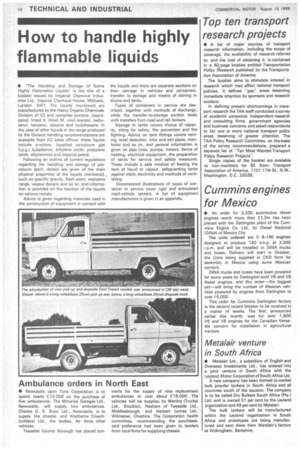How to handle highly flammable liquids
Page 28

If you've noticed an error in this article please click here to report it so we can fix it.
• "The Handling and Storage of Some Highly Flammable Liquidsis the title of a booklet issued by Imperial Chemical Industries Ltd., Imperial Chemical House, Mil'bank, London. SW1. The liquids mentioned are manufactured by the Heavy Organic Chemicals Division of ICI and comprise acetone, isopropanol, Imsol A, Imsol M, vinyl acetate, isobutanol, benzene, toluene and cyclohexane. In the case of other liquids in the range produced by the Division handling recommendations are available from ICI sales offices; these liquids include p-xylene, liquefied petroleum gas
butadience, ethylene oxide, propylene oxide. alkylamines and imperial petrol. _ Following an outline of current regulations regarding the handling and storage of petroleum spirit, details are given of the main physical properties of the liquids mentioned_ such as specific gravity, flash point, explosive range, vapour density and so on. and information is provided on the reaction of the liquids on various metals.
Advice is given regarding materials used in the construction of equipment in contact with the liquids and there are separate sections on their carriage in vehicles and containers, transfer to storage and means of storing in drums and tanks.
Types of containers in service are described, together with methods of discharge, while the transfer-to-storage section deals with transfers from road and rail tankers.
Storage in tanks covers choice of capacity, siting for safety, fire prevention and fire fighting. Advice on tank fittings covers venting, level detection, inlet and exit pipes, manholes and so on, and general information is given on pipe lines, pumps, meters, forms of heating, electrical equipment, the preparation of tanks for service and safety measures. These include a safe method of freeing the tank of liquid or vapour, safeguarding tanks against static electricity and methods of ventilating.
Dimensioned illustrations of types of container in service cover rigid and articulated road-vehicle tankers. A list of equipment manufacturers is given in an appendix.






































































































